创建一个带有地形的环境 允许您在 3D 空间生成和自定义看起来和真实世界的自然材料一样的有机材料。使用 地形编辑器 内的工具,本节教程向您展示如何为玩家生成和雕刻小岛上的地形,以便他们导航到体验的前几个平台。
在开始之前,要注意雕刻地形是一种艺术形式,很难准确重现画笔触及和微妙材质编辑。只要您的地形满足自己的体验需求,就正常且可预期的是您的环境看起来和感觉上与样本 岛跳跃 体验不同。
创建岛上
创建环境的第一步是创建一个小岛,玩家在开始体验时会生成,当他们从平台上掉下来后,生命值达到零时会生成。使用地形编辑器的 绘制 工具,您可以单击并拖动窗口内的任何位置,生成大型地形球,以启动岛屿,之后您可以塑形并压平它以获得大面积的表面。
要创建岛屿:
导航到工具栏的 主页 选项卡,然后单击 地形编辑器 按钮。
在 地形编辑器 窗口中,单击 编辑 选项卡,然后单击 绘制 按钮。
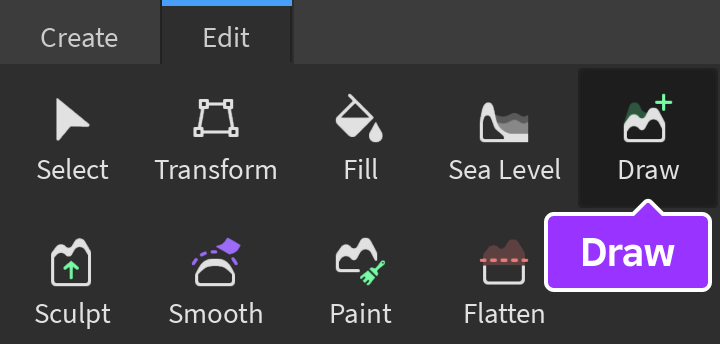
在 刷子设置 和 材料设置 部分中,保留所有默认设置,除了以关注中/正在关注内容:

设置 刷子尺寸 为 32 .
将源材料设置为 沙子 .
在视图中,单击视图中生成位置附近的沙子材料球。显示沙子材料球。
塑造岛屿
如果您保持岛屿的当前形状,玩家将很难在没有掉落岛屿的情况下导航。使用地形编辑器的 平坦化 工具,您可以单击并拖动球体以在固定平面上平坦地形,并为玩家提供相对平坦的表面,让他们开始体验。虽然这个形状最初看起来不自然,但你也可以使用地形编辑器的 雕刻 工具在岛的边缘为它确保看起来有机和真实。
要塑造岛屿:
在 地形编辑器 窗口中,单击 扁平化 按钮。
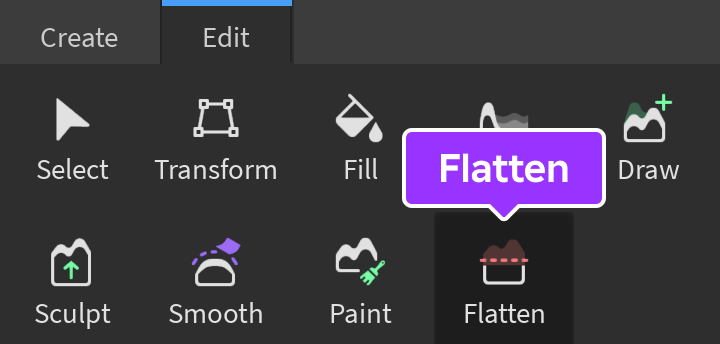
在 刷子设置 部分,保留所有默认设置,除了以关注中/正在关注内容:

- 设置 刷子尺寸 为 18。:
- 设置 扁平飞机 到 固定 。新设置显示。:
- 设置 固定Y飞机 到 0。
在视图中,单击并拖动鼠标在球上,直到完全平坦为止。
导航回到 地形编辑器 窗口,然后单击 雕刻 按钮。
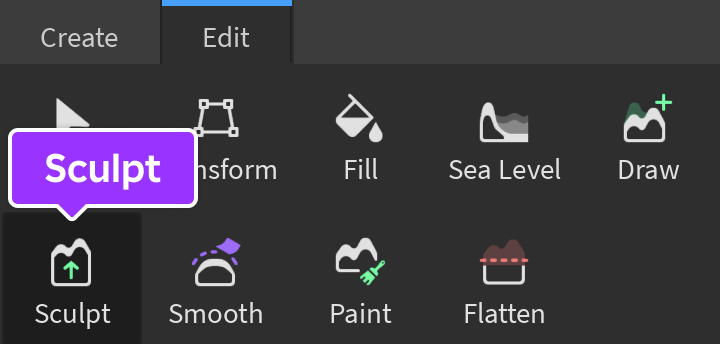
在 刷子设置 和 材质设置 部分中,将 源材料 设置为 沙子 ,否则保留所有默认设置。

在视图中,单击并拖动鼠标沿岛边和水线下方,使岛屿看起来更自然。
创建水
虽然有多种方法可以生成大量水域,但以下说明使用了地形编辑器的 填充 工具。这种方法可以让你在特定区域替换任何材料,包括空气本身。
要创建岛周围的水域:
在 地形编辑器 窗口中,单击 填充 按钮。
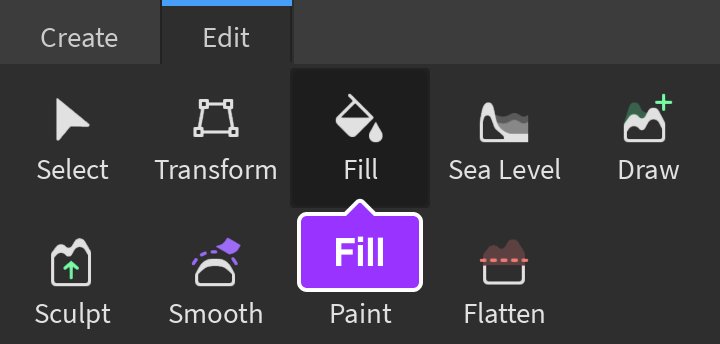
在 选择设置 部分,
- 将 位置 设置为0, -15, 0以确保水充满岛上的顶部。
- 将 尺寸 设置为 1800, 5, 1800 以确保水流向你的体验地平线。
在 材料设置 部分中,配置工具以下设置:

- 设置 填充模式 到 替换 。:
- 设置 来源材料 到 空气 。:
- 设置 目标材料 到 水 。
点击 应用 按钮。水在岛上生成。
应用材料
现在你已经有了你岛屿的基础,你可以用不同的材料来自定义其外观。使用地形编辑器的 涂色工具 ,您可以单击并拖动您的地形,将草地表面和草片应用到岛的中心。
要将材料应用到岛上:
在 地形编辑器 中,单击 绘制 按钮。
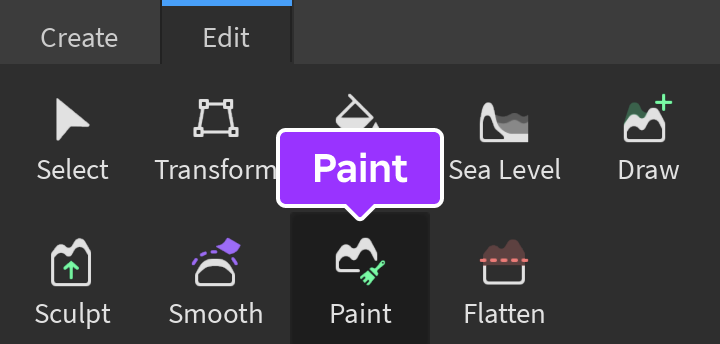
在 刷子设置 和 材料设置 部分中,保留所有默认设置,除了以关注中/正在关注内容:

- 设置 材质模式 到 油漆 。:
- 设置 源材料 到 叶状草 。
在视图中,单击并拖动岛的中间部分以应用叶状草材料。
导航回到 地形编辑器 窗口,然后在 刷子设置 和 材料设置 部分中,
- 将 刷子尺寸 设置为 3。
- 将 材料 设置为 草 。
在视图中,沿着岛的边缘拖动以应用草刃,留出岛中间的空间作为生成位置和初始平台。
在 Explorer 窗口中,选择 SpawnLocation 对象。
在工具栏的 主页 选项卡中,选择 移动 工具。
在视图中,将生成位置移向岛的边缘,以腾出空间放置第一台平台。示例 岛屿跳跃 - 建造.rbxl 文件使用了一个位置 -127, -3, 9 .
游戏测试
一旦你对你的岛屿的外观满意,你就可以测试你的体验来检查岛屿的规模以及在你体验的 3D 世界中的感觉。
要测试您的体验:
从游戏测试选项中单击 播放 按钮。

在岛上走走,看看它在游戏时的样子。当你完成后,单击 停止 按钮。工作室退出游戏测试模式。

在教程的下一部分中,你将学习如何创建一个可供玩家跟随的可玩区域,以达到最高平台。